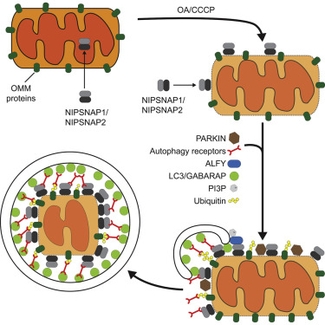Abstract
The clearance of damaged or dysfunctional mitochondria by selective autophagy (mitophagy) is important for cellular homeostasis and prevention of disease. Our understanding of the mitochondrial signals that trigger their recognition and targeting by mitophagy is limited. Here, we show that the mitochondrial matrix proteins 4-Nitrophenylphosphatase domain and non-neuronal SNAP25-like protein homolog 1 (NIPSNAP1) and NIPSNAP2 accumulate on the mitochondria surface upon mitochondrial depolarization. There, they recruit proteins involved in selective autophagy, including autophagy receptors and ATG8 proteins, thereby functioning as an “eat me” signal for mitophagy. NIPSNAP1 and NIPSNAP2 have a redundant function in mitophagy and are predominantly expressed in different tissues. Zebrafish lacking a functional Nipsnap1 display reduced mitophagy in the brain and parkinsonian phenotypes, including loss of tyrosine hydroxylase(Th1)-positive dopaminergic (DA) neurons, reduced motor activity, and increased oxidative stress.

Be the first to leave a comment!